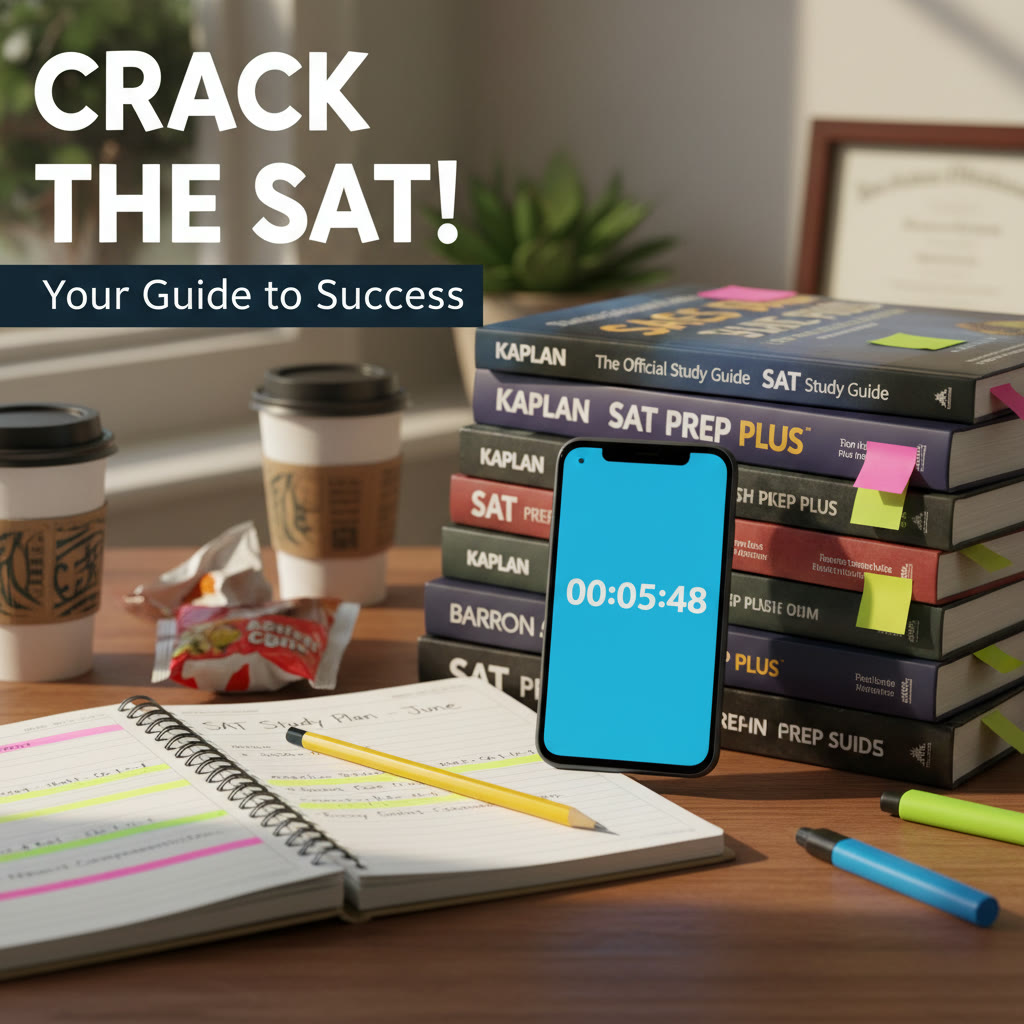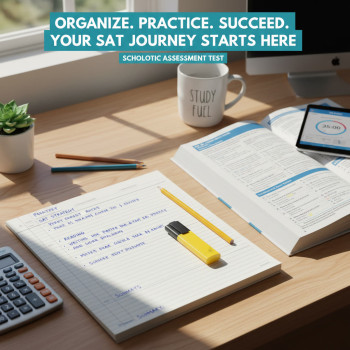Why Time-Blocking Is the Secret Weapon Busy Students Miss
If you feel like your SAT prep is slipping between classes, sports, clubs, and family commitments, you are not alone. The calendar of a typical high school student is a collage of overlapping responsibilities. Time-blocking is a simple, practical approach that turns that collage into a clean, intentional plan. Instead of stealing random 15-minute windows here and there, time-blocking helps you reserve uninterrupted, meaningful study periods that actually move your score forward.

What time-blocking actually means
Time-blocking means assigning specific chunks of time on your calendar for one concrete task and protecting that time. For SAT prep, a block could be 45 minutes of targeted Math practice, a 30-minute vocabulary review, or a full 3-hour practice test. The point is to design focused sessions, not vague intentions like ‘study SATs sometime tonight.’
Why it works better than vague to-do lists
- Reduces decision fatigue: you already know what you will do when the block starts.
- Creates momentum: repeated, consistent blocks build skill and stamina.
- Improves focus: your brain shifts into a single-task mode, making practice more efficient.
- Makes review measurable: you can track completed blocks and adjust plans.
Designing a SAT-Friendly Weekly Time-Blocking System
Good time-blocking is personal. But busy students share common constraints: fixed school hours, extracurriculars, social time and homework. Your plan must be realistic, flexible, and sustainable. Below is a step-by-step blueprint you can adapt.
Step 1: Audit your current week
Start by tracking every hour for three days: classes, commute, meals, homework, free time, sleep. This audit reveals pockets—early mornings, study halls, or the hour after practice—where consistent study blocks can live.
Step 2: Prioritize your SAT goals
Identify the score range you want and the subject weaknesses to address. If Reading is already strong but Math lags by 50 points, shift more blocks to targeted Math work. Prioritization keeps blocks meaningful.
Step 3: Choose block lengths that match your energy
Not all blocks need to be long. Typical effective lengths:
- Short focused practice: 25–40 minutes (great for vocabulary, formula review)
- Moderate skill work: 45–75 minutes (ideal for problem sets and mixed practice)
- Full mock tests: 3–4 hours (simulates test day and builds endurance)
Step 4: Build a weekly template
Templates reduce friction—when you know Monday 6–7 pm is Math, you just show up. Below is a sample week for a student with school 8 am–3 pm and sports three evenings a week. Tweak the times to your life.
| Day | Morning Block | After School | Evening |
|---|---|---|---|
| Monday | 20-minute vocab warm-up | 45-minute Math practice | Homework + 25-minute review of missed problems |
| Tuesday | 30-minute grammar drill | 60-minute reading comprehension mix | Team practice (light review after) |
| Wednesday | 20-minute flashcard review | 45-minute Math problem set | 60-minute mixed practice (timed sections) |
| Thursday | 30-minute critical reading drill | 30-minute targeted concept review | Homework + reflection on week’s work |
| Friday | Easy 25-minute vocabulary | 60-minute full section practice (timed) | Rest or light review |
| Saturday | 3-hour practice test (with breaks) | Review test errors (60–90 minutes) | Relax and recharge |
| Sunday | Two 45-minute targeted blocks | Plan next week + 30-minute spaced repetition | Prep materials for Monday |
Sample Daily Time-Block: Real-Life Student Example
Meet Mia, a junior who takes school from 8 am–3 pm, runs track, and volunteers twice a week. She has two math weak spots and wants to raise her SAT score by 80 points in three months. Here is a realistic weekday plan that fits her life without burning her out.
Mia’s weekday time-block
- 6:45–7:15 am: Morning quick-hit block — vocabulary and formula review (30 minutes)
- 8:00–15:00: School — use short study hall for 15 minutes of flashcard review
- 15:30–16:30: Track practice
- 17:30–18:15: Focused Math block — targeted problem sets (45 minutes)
- 18:30–19:15: Dinner + unwind
- 19:15–20:00: Light review — go over mistakes from Math block or complete a short reading passage timed (45 minutes)
- 20:15–20:30: Plan next day + quick spaced repetition flashcards (15 minutes)
Notice the structure: shorter morning blocks when the brain is fresh for facts, a longer evening block for deeper practice, and a short planning period to keep the system running. This approach gives Mia 6–8 quality SAT study hours per week integrated with her life.
How to Choose What to Put in Each Block
Not all study is equal. Your blocks should be intentional and diverse. Here are common block types and how to use them effectively.
| Block Type | Goal | Typical Length |
|---|---|---|
| Targeted skill work | Fix specific weaknesses (e.g., quadratic equations) | 45–75 minutes |
| Timed section practice | Improve pacing and endurance | 60–90 minutes |
| Full practice test | Simulate test day and track progress | 3–4 hours |
| Active review | Deeply analyze errors, create target lists | 30–90 minutes |
| Spaced repetition | Commit facts and strategies to memory | 10–30 minutes |
Example: What a Math targeted block looks like
Pick a narrow objective: ‘Master linear equation word problems with two variables.’ Warm up with a 5-minute review of steps, spend 30–40 minutes on mixed-level problems, then spend 5–10 minutes summarizing patterns and creating flashcards for tricky setups. Finish by flagging three problems to review in the next spaced-repetition block.
Practical Rules to Make Time-Blocking Stick
Building the blocks is easy. Protecting them is the tricky part. Here are rules that increase follow-through.
- Set a non-negotiable start time and a clear objective for each block.
- Treat blocks like appointments—put them on your calendar and set reminders.
- If you miss a block, reschedule it immediately rather than skipping the work.
- Keep a short ‘pre-block routine’—warm up materials, set timer, and close distracting apps.
- Use small rewards after consistent blocks: a walk, a favorite snack, or a TV episode.
Handling interruptions
Life happens—practices run late, family events pop up. When interrupted, be honest about what you can salvage. If you can’t get the planned 45 minutes, do a 25-minute focused sprint to preserve momentum. If you’ll miss multiple blocks in a week, add longer weekend sessions instead of panicking.
Integrating Practice Tests and Review
Practice tests are the compass for your time-blocking strategy. They reveal the precise areas to target in your weekly blocks.
When to take a full practice test
- Baseline: take one before you start a time-block plan to measure where you are.
- Every 2–3 weeks during heavy prep to monitor progress and adjust blocks.
- Finally, 1–2 full timed tests in the last two weeks before test day to build endurance and test-day routines.
After every test, schedule a dedicated review block where you do an error analysis: categorize mistakes, identify patterns, and create 3–5 highly specific action items for the next two weeks of blocks. This is where the recommendations from tools like Sparkl’s personalized tutoring can accelerate gains: their expert tutors and AI-driven insights help convert test errors into a focused, tailored study plan that slots neatly into your blocks.
Advanced Tweaks: Pomodoro, Theme Days, and Energy Matching
Pomodoro for micro-focus
If you struggle to sustain attention, try Pomodoro-style blocks: 25 minutes work, 5 minutes break, repeated 3–4 times, then a longer break. This is especially helpful for grammar drills or dense review sessions.
Theme days for depth
Consider dedicating a day to a single subject or skill—’Math Monday’ or ‘Reading Wednesday’. Theme days reduce context switching and accelerate deep mastery, which is valuable in the weeks before a test.
Match block difficulty to your energy rhythms
Most students have peak focus in the morning or early evening. Schedule heavy conceptual work when you feel freshest and lighter review or flashcards when energy dips. This energy-aware scheduling keeps your blocks efficient and less frustrating.
Tracking Progress Without Overwhelm
Tracking is key, but it shouldn’t become another chore. Use a simple system:
- Check off completed blocks on your calendar.
- Keep a one-page weekly log: what you worked on and one sentence about progress.
- After each practice test, record score, timing issues, and top 3 priorities for the next week.
For students who want an added layer of personalization, Sparkl’s tailored study plans and expert tutors can help interpret progress data and suggest adjustments to your block schedule. Their AI-driven insights identify weak patterns quickly, letting you convert small time blocks into big score improvements.
Sample 8-Week Time-Blocking Plan
The following is a condensed roadmap you can adapt. It assumes a 2–3 month ramp-up with 6–8 weekly SAT-focused hours on top of schoolwork.
- Weeks 1–2: Baseline test, identify weak areas, establish a weekly template with 3 targeted blocks and 1 full practice test.
- Weeks 3–4: Increase targeted work, add timed sections, use spaced repetition daily. Review errors after every practice test.
- Weeks 5–6: Shift to mixed practice—timed sections and endurance building. Add one simulated test every 10 days.
- Weeks 7–8: Peak—focus on pacing, mental routines, and 1–2 full-length tests; taper intensity in the final week to arrive rested.
Common Pitfalls and How to Avoid Them
- Overbooking: Don’t schedule so many blocks that you can’t sustain. Consistency wins over intensity.
- Vague objectives: Each block must have a specific outcome, not just ‘study’.
- Ignoring test simulation: If you never practice full tests, you miss pacing and fatigue issues.
- Failing to review mistakes: A completed block without reflection is a missed learning opportunity.
Tools and Rituals That Make Blocks Easier
Use a calendar app to schedule and remind, but keep a simple paper or digital checklist for quick tracking. Create a short pre-block ritual: drink water, silence phone, open the exact page, and set a timer. Small rituals reduce procrastination by making it easy to begin.

Putting It All Together: Your First 7-Day Trial
Try this experiment for one week to build confidence with the method:
- Day 1: Take a 30-minute diagnostic timed section to set a baseline.
- Days 2–6: Follow a simple template—one 45-minute targeted block, one 30-minute timed practice, and daily 15-minute spaced repetition.
- Day 7: Take a full practice section or use two longer blocks and review the week. Adjust the next week’s blocks based on what you learned.
After the week, ask: Did the blocks feel realistic? Which times worked best? Which blocks produced the most learning? Use the answers to refine your template.
Final Thoughts: Consistency Beats Motivation
Motivation comes and goes. Time-blocking creates a system that carries you forward even on low-motivation days. When you protect small, regular blocks and make review non-negotiable, you build both skill and confidence. If you want extra structure, remember that resources like Sparkl’s personalized tutoring offer 1-on-1 guidance, tailored study plans, and AI-driven insights that plug directly into your blocks—helping you refine priorities and accelerate progress without adding chaos to a busy schedule.
Commit to a trial week, keep your blocks realistic, and focus on measurable outcomes. Over time, those protected hours add up into reliable progress—and when test day arrives, you’ll be amazed at how much calm and competence can come from a few well-planned blocks each week.
Quick checklist to start tomorrow
- Audit one day of your schedule to find study pockets.
- Choose three weekly blocks to make non-negotiable.
- Schedule one full practice section every 10 days.
- Do a 5-minute review after each block and log one action item.
- Adjust based on energy, results, and life commitments.
Go build your blocks
Start small, stay consistent, and treat time-blocking as a flexible tool—not a rigid trap. With intention, a realistic plan, and consistent reflection, you can balance school, life, and meaningful SAT progress. Good luck—you’ve got this.


















No Comments
Leave a comment Cancel